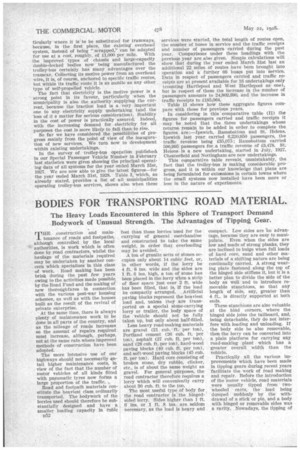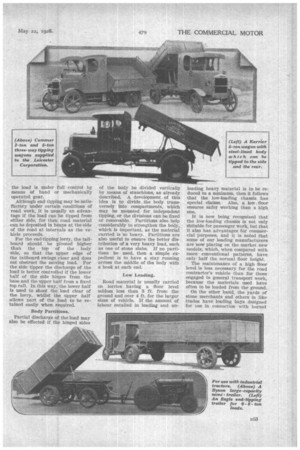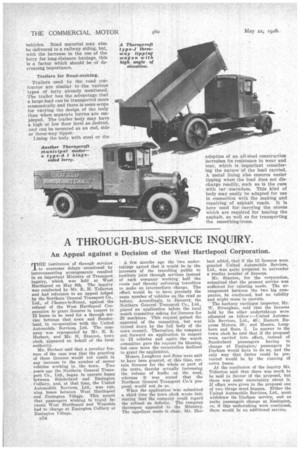BODIES FOR TRANSPORTING ROAD MATERIAL.
Page 126

Page 127

Page 128

If you've noticed an error in this article please click here to report it so we can fix it.
The Heavy Loads Encountered in this Sphere of Transport Demand Bodywork of Unusual Strength. The Advantages of Tipping Gear.
filHE construction and main tenance of roads and footpaths, although controlled by the local authorities, is work which is often done by road contractors, whilst the haulage of the materials required may be undertaken by another concern which specializes in this class of work. Road making has been brisk during the past few years owing to the activities made possible by the Road Fund and the making of new thoroughfares in connection with the various post-war housing schemes, as well as with the houses built as the result of the revival of private enterprise.
At the same time, there is always plenty of maintenance work to be done in all parts of the country, and as the mileage of roads increases so the amount of repairs required must increase, although, perhaps, not at the same rate where improved methods of construction have been adopted.
The more intensive use of our highways should not necessarily viten higher maintenance costs, in view of the fact that the number of motor vehicles of all kinds fitted with pneumatic tyres now forms a large proportion of the traffic,.
Road and footpath materials constitute the heaviest class ordinarily transported. The bodywork of the lorries used should therefore be substantially designed and have a smaller loading capacity in cubic n52 feet than those lorries used for the carrying of general merchandise and constructed to take the same weight, in order that overloading may be avoided.
A ton of granite setts or stones occupies only about 14 cubic feet, or, in other words, if the lorry be 4 ft. 6 ins, wide and the sides are 1 ft. 6 ins, high, a ton of stone has been placed in the lorry when a strip of floor space just over 2 ft. wide has been filled, that is, if the load be compactly arranged. . Artificial paving blocks represent the heaviest load and, unless they are transported on a special stone-carrying lorry or trailer, the body space of the vehicle should not be fully taken up, but only about half-filled.
Less heavy road-making materials are gravel (21 cub. ft. per ton), Portland cement (26 cub. ft. per ton), asphalt (27 cub. ft. per ton), sand (28 cub. ft. per ton), hard-wood paving blocks (40 cub. ft. per ton), and soft-wood paving blocks (45 cub. ft. per ton). Hard core consisting of broken stone, dry rubble, clinker, etc., is of about the same weight as gravel. For general purposes, the read contractor therefore requires a lorry which will conveniently carry about 30 cub. ft. to the ton.
The most useful type of bogy for the road contractor is the hingedsided lorry. Sides higher than 1 ft. 6 ins. or 1 ft. 8 ins, are seldom necessary, as the load is heavy and compact. Low sides are in advantage, because they are easy to manipulate. Even when the sides are low and made of strong planks, they are inclined to bulge when full loads of hard core, sand and other materials of a shifting nature are being continually carried. A strong wearing plate fastened along the top of the hinged side stiffens it, but it is a better plan to divide the side of the body as well and to introduce removable stanchions, so that any length of side, say, greater than 4 ft.. is directly supported at both ends.
These stanchions are also valuable at the hind corners, where the hinged side joins the tailboard, and, being detachable, they do not interfere with loading and unloading. If the body side be also removable, then the lorry can be converted into a plain platform for carrying any road-making plant which has a greater overall width than the vehicle.
Practically all the various improvements which have been made in tipping gears during recent years facilitate the work of road making and repair. Before the introduction of the motor vehicle, road materials were usually tipped from twowheeled carts, the load being dumped suddenly by the withdrawal of a stick or pin, and a body with hinged or removable sides was a rarity. Nowadays, the tipping of the load is under full control by means of hand or mechanically operated gear. Although end tipping may be satisfactory under certain conditions of road work, it is usually an advantage if the load can be tipped from either side, for then road material can be deposited in heaps at the side of the road at intervals as the vehicle proceeds.
For the end-tipping lorry, the tailboard should be pivoted higher than the top of the body side, so that the upper edge of the tailboard swings clear and does not obstruct the moving load. For the side tipper the discharge of the load is better controlled if the lower half of the side hinges from the base and the upper half from a fixed top rail. In this way, the lower half is used to shoot the load clear of the lorry, whilst the upper half allows part of the load to be retained easily when required.
Body Partitions.
Partial discharge of the load may also be effected if the hinged sides
of the body, be divided vertically by means of stanchions, as already described. A development of this idea is to divide the body transversely into compartments, which may be mounted for independent tipping, or the divisions can be fixed or removable. Partitions also help :considerably to strengthen the body, which is important, as the material carried is so heavy. Partitions are also useful to ensure the better distribution of a very heavy load, such as one of stone slabs. If no partitions be used, then a simple expedient is to have a stay running across the middle of the body with a hook at each end.
Low Loading.
Road material is usually carried OD lorries having a floor level seldom less than 3 ft. from the ground and over 4 ft. for the larger sizes of vehicle. If the amount of labour entailed in loading and un
loading heavy material is to be reduced to a minimum, then it follows that the low-loading chassis has special claims. Also, a low floor ensures safer working than a high one.
It is now being recognized that the low-loading chassis is not only sbitable for passenger work, but that it also has advantages for commercial purposes, and it is noted that some of our leading manufacturers are now placing on the market new models, which, when compared with more conventional patterns, have only, half the normal floor height.
The maintenance of a high floor level is less necessary for the road contractor's vehicle than for those engaged in general transport work, because the materials used have often to be loaded from the ground.
On the other hand, the yards of stone merchants and others in like trades have loading bays designed for use in connection with horsed vehicles. Road material may also be delivered to a railway siding, but, with the increase in the use of the lorry, for long-distance haulage, this is a factor which should be of decreasing importance.
Trailers for Road-making.
Trailers used by the road contractor are similar to the various types of lorry already mentioned. The trailer has the advantage that a large load can be transported more economically and there is more scope for varying the design of the body than when separate lorries are employed. The trailer body may have a high or low floor level as desired, and can be mounted as an end, side or three-way tipper.
Lining the body with steel or the adoption of an all-steel construction increases its resistance to wear and tear, which is important considering the nature of the load carried. A metal lining also ensures easier tipping when the load does not discharge readily, such as is the case with tar macadam. This kind of body may easily be adapted for use in connection with the making and repairing of asphalt roads. It is here used for carrying the stoves which are required for heating the asphalt, as well as for transporting the smoothing-irons.




















































































































































































































